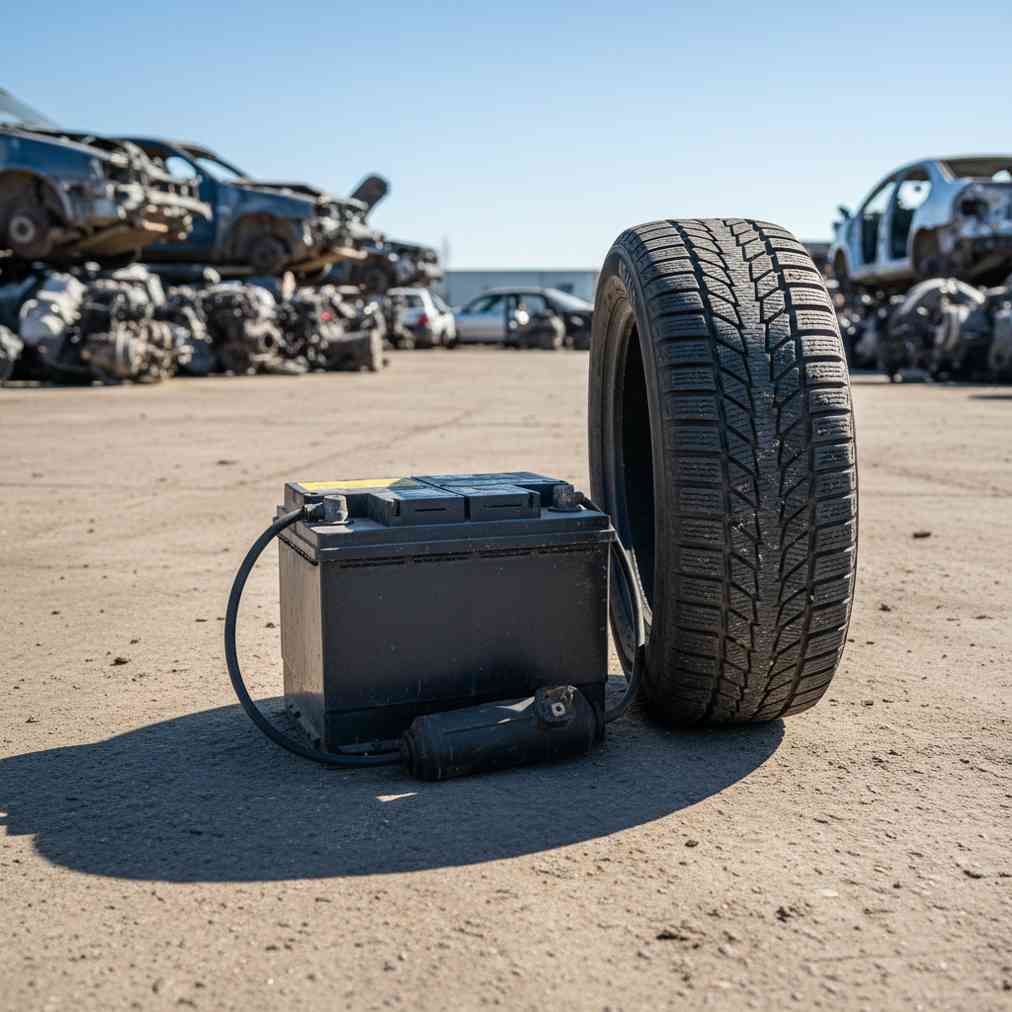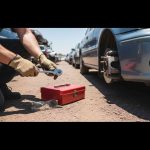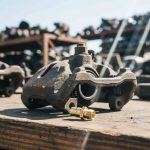Winter Auto Parts: Essential Salvage Yard Finds for Cold Weather Preparation
Preparing your vehicle for harsh winter conditions doesn’t have to drain your wallet. Auto salvage yards offer excellent opportunities to source essential winter car parts at up to 60 percent less than new retail prices. Whether you’re dealing with snow, ice, or freezing temperatures, these five critical parts from junkyards near me can keep your vehicle running safely and reliably throughout the winter season.
Smart car owners know that winter preparation is crucial for both safety and avoiding costly roadside emergencies. By sourcing quality used parts from salvage yards, you’re not only saving money but also supporting automotive recycling efforts that benefit the environment.
Winter Tires and Steel Wheels: Your Foundation for Winter Safety
Winter tires are arguably the most critical investment for cold-weather driving. These specialized tires feature softer rubber compounds that remain flexible in freezing temperatures, along with aggressive tread patterns designed to bite into snow and ice. Finding a complete set of used winter tires mounted on steel wheels can save hundreds compared to buying new.
Steel wheels are particularly valuable for winter use because they resist damage from road salt and potholes better than expensive alloy wheels. Many drivers prefer keeping their factory wheels pristine while using dedicated steel wheels for harsh winter conditions.
Inspection Checklist for Used Winter Tires
- Tread Depth Measurement: Use a tread depth gauge or perform the penny test. You should have a minimum of 6/32 inch of tread depth for adequate winter traction
- Even Wear Patterns: Check that wear is consistent across the entire tread surface. Uneven wear may indicate previous alignment or suspension issues
- Sidewall Integrity: Carefully inspect sidewalls for cuts, nicks, bulges, or weather cracking that could lead to failure
- Steel Wheel Condition: Look for excessive rust that might compromise the tire bead seal or structural integrity. Ensure lug nut holes aren’t stripped or damaged
According to winter tire research, proper tread depth is crucial for maintaining control in snow and slush conditions. Don’t compromise on safety by accepting tires with insufficient tread.
High-Capacity Car Batteries for Cold Weather Starting
Cold weather can reduce a car battery’s capacity by up to 50 percent, while engines require significantly more current to start in freezing temperatures. A reliable used battery from a low-mileage donor vehicle can provide excellent value compared to new battery prices.
The key is finding batteries from vehicles that weren’t exposed to extreme conditions or deep discharge cycles. Batteries from newer vehicles or those with lower mileage typically offer the best performance and longevity.
Battery Testing and Inspection Protocol
| Test Type | Acceptable Reading | Action Required |
|---|---|---|
| Resting Voltage | 12.6V or higher | Good condition |
| Resting Voltage | 12.0-12.5V | Needs charging/testing |
| Resting Voltage | Below 12.0V | Likely replacement needed |
- Physical Inspection: Look for swelling, cracks, or leaks in the battery case
- Terminal Condition: Check for excessive corrosion (white or blue-green buildup)
- Cable Integrity: Ensure battery cables aren’t cracked or corroded
- Load Testing: If possible, perform a load test to verify cranking power
For comprehensive guidance on battery selection and testing, check out our detailed guide on buying used car batteries from salvage yards.
Engine Block Heaters: Essential for Extreme Cold Climates
Engine block heaters are invaluable in regions where temperatures regularly drop below freezing. These devices keep the engine block and oil warm, reducing wear during startup and ensuring your heater and defroster work more quickly. While new block heaters can be expensive, finding a functional used unit offers significant savings.
Block heaters are particularly common on vehicles from northern climates, making salvage yards in cold-weather regions excellent sources for these parts. The investment pays for itself through reduced engine wear and improved cold-weather reliability.
Block Heater Safety and Compatibility Check
- Power Cord Inspection: Examine the entire cord length for cuts, fraying, or exposed wires – this is critical for electrical safety
- Heating Element Condition: Check the probe for significant corrosion or physical damage
- Mounting Hardware: Verify that brackets and threaded connections are intact and not stripped
- Vehicle Compatibility: Confirm the part number matches your specific make, model, and engine size
Advanced automotive technologies, as discussed in recent automotive research, are making winter preparation more sophisticated, but traditional solutions like block heaters remain highly effective for cold-weather starting.
Windshield Washer Systems and Winter Visibility Parts
Maintaining clear visibility is paramount during winter driving. Standard washer fluid freezes in cold temperatures, rendering your windshield washer system useless when you need it most. A complete, undamaged washer reservoir is essential for holding adequate volumes of freeze-resistant fluid.
Winter driving creates unique visibility challenges with salt spray, slush, and ice buildup on windshields. A properly functioning washer system paired with quality wiper blades can mean the difference between safe travel and dangerous conditions.
Washer System Component Inspection
Reservoir Assessment:
- Fill with water to test for leaks around seams and connections
- Check all hose connection points for cracks or brittleness
- Verify the reservoir cap seals properly
- Ensure mounting tabs aren’t broken or damaged
Wiper Blade Evaluation:
- Inspect rubber edges for cracks, tears, or hardening
- Test wiper arm attachment mechanisms for proper fit
- Check for proper spring tension in the wiper arms
While wiper blades are often better purchased new due to rubber degradation, finding quality used wiper motors and washer pumps can provide significant savings for winter preparation projects.
Cooling System Belts and Hoses for Winter Reliability
Cold temperatures cause rubber parts like belts and hoses to become brittle and prone to failure. A cooling system leak or belt failure in winter conditions can strand you in dangerous situations. Preventive replacement with quality used parts ensures reliability when you need it most.
The cooling system works harder in winter than many people realize. While the engine may run cooler, the heater core, radiator, and associated hoses face constant temperature cycling that can cause failures in weakened components.
Cooling System Component Evaluation
| Component | Good Condition Signs | Replacement Needed |
|---|---|---|
| Radiator Hoses | Firm but flexible, no visible cracks | Spongy, brittle, or swollen |
| Heater Hoses | No bulging or soft spots | Surface cracking or hardening |
| Drive Belts | No deep cracks on underside | Fraying or separation of layers |
| Hose Clamps | Minimal surface rust | Heavy corrosion or stripped threads |
When selecting used cooling system parts, prioritize those from vehicles with documented maintenance history or lower mileage. These parts typically haven’t experienced the stress cycles that lead to premature failure.
Professional Junkyard Shopping Tips for Winter Parts
Successfully sourcing winter preparation parts requires strategy and preparation. Experienced junkyard shoppers follow specific protocols to ensure they get quality parts at fair prices while avoiding common pitfalls.
Essential Preparation Steps
- Research Part Numbers: Know your vehicle’s exact specifications using the VIN or owner’s manual
- Bring Testing Equipment: Pack a multimeter, tire gauge, and basic tools for evaluation
- Clean and Inspect Thoroughly: Use electrical contact cleaner on connections and look for hidden damage
- Document Part Condition: Take photos before removal for reference during installation
Current automotive industry research shows that proper part identification and compatibility checking reduces installation problems by over 70 percent.
Safety and Efficiency Guidelines
- Wear appropriate safety gear including gloves and eye protection
- Bring a helper for removing heavy parts like batteries and wheels
- Plan your visit during peak hours when yard staff are available for assistance
- Keep receipts and part information for warranty purposes
For those looking to maximize their salvage yard experience, our comprehensive guide on smart junkyard shopping strategies provides detailed insights into finding the best deals and highest quality parts.
Maximizing Your Winter Preparation Investment
Winter vehicle preparation through strategic salvage yard shopping can save hundreds of dollars while ensuring reliable cold-weather performance. The key is focusing on essential systems that directly impact safety and reliability rather than cosmetic improvements.
Quality used parts from salvage yards often provide better value than cheap aftermarket alternatives. OEM parts maintain original specifications and fitment, reducing installation challenges and improving long-term reliability.
If you’re considering upgrading your current vehicle or need to sell an older car to fund winter preparations, getting an instant quote for your junk car can provide immediate funds for essential winter parts and maintenance.
Budget-Friendly Winter Preparation Timeline
| Priority Level | Parts to Source | Estimated Savings |
|---|---|---|
| Critical | Battery, Winter Tires | $200-400 |
| Important | Belts, Hoses, Washer System | $100-200 |
| Beneficial | Block Heater, Spare Parts | $150-300 |
The automotive industry continues evolving with new technologies and approaches, as shown in recent automotive innovation videos, but fundamental winter preparation principles remain constant. Reliable starting, adequate traction, and clear visibility are non-negotiable requirements for safe winter driving.
Environmental Benefits of Used Auto Parts
Choosing used parts for winter preparation supports environmental sustainability by extending the lifecycle of automotive parts that would otherwise be scrapped. This approach reduces demand for new manufacturing while keeping functional parts in circulation.
Modern research on sustainability and recycling demonstrates that automotive recycling saves significant energy and raw materials compared to manufacturing new parts. Every used part purchased represents reduced environmental impact and resource conservation.
By sourcing winter preparation parts from salvage yards, you’re participating in the circular economy while maintaining your vehicle’s safety and reliability. This approach proves that environmental responsibility and practical vehicle maintenance can work together effectively.
Smart winter preparation using quality salvage yard parts ensures your vehicle remains safe and reliable throughout the cold season while keeping more money in your pocket for other important expenses. Start your search early, inspect thoroughly, and prioritize safety-critical systems for the best results.





Leave a Reply
You must be logged in to post a comment.